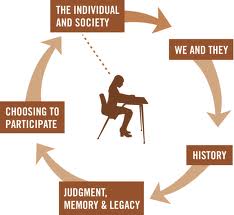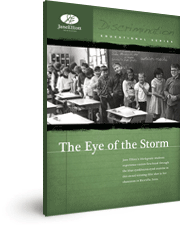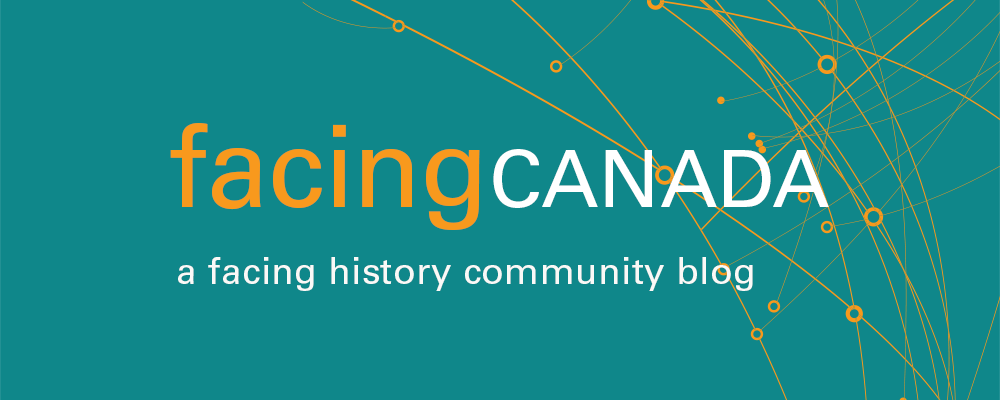With any new course, teachers will often ask themselves, “Where do I begin?” This is an even more daunting question when dealing with such a difficult subject as genocide. In my preparation for teaching the Grade 11 Genocide and Crimes Against Humanities course at Louise Arbour Secondary School, I asked myself, “How can the students and I relate to situations that are so extreme and beyond most of our experiences?”
I didn't want the course to be reduced to a listing of the various data and statistics of many genocides. I wanted to humanize the history so that we could connect with the people and not just learn dates and numbers.
The course begins, not with a focus on genocide from a historical context, but with an exploration of issues and questions of identity and membership, which is also the start of the Facing History Scope and Sequence.
 The focus on identity serves as the foundation for the rest of the course and the lens through which we examine each of the case studies of genocide that we look at throughout the course, such as Armenia, the Holocaust, and Rwanda. We explore issues of identity such as race, religion, gender, and sexuality, among others. We explore how group identities can influence individuals and create both inclusion and exclusion. We focus on the power of stereotypes, prejudice, and discrimination. This is especially important in opening a dialogue in which students can feel comfortable asking honest questions and challenging assumptions. These are the moments that a student will nervously ask, “But aren't stereotypes true?” I try to avoid the facile answers of “Yes or No” and instead deal with stereotypes as distortions and limitations of half-truths. All of this serves the purpose of encouraging and allowing students to think critically about how they see themselves and others and to understand both how these perceptions can be manipulated, but also how they can be challenged and broadened. Throughout the rest of the course, we continually return to these issues and concepts of identity and membership to help us gain a more complete understanding of why and how genocides and crimes against humanity occur.
The focus on identity serves as the foundation for the rest of the course and the lens through which we examine each of the case studies of genocide that we look at throughout the course, such as Armenia, the Holocaust, and Rwanda. We explore issues of identity such as race, religion, gender, and sexuality, among others. We explore how group identities can influence individuals and create both inclusion and exclusion. We focus on the power of stereotypes, prejudice, and discrimination. This is especially important in opening a dialogue in which students can feel comfortable asking honest questions and challenging assumptions. These are the moments that a student will nervously ask, “But aren't stereotypes true?” I try to avoid the facile answers of “Yes or No” and instead deal with stereotypes as distortions and limitations of half-truths. All of this serves the purpose of encouraging and allowing students to think critically about how they see themselves and others and to understand both how these perceptions can be manipulated, but also how they can be challenged and broadened. Throughout the rest of the course, we continually return to these issues and concepts of identity and membership to help us gain a more complete understanding of why and how genocides and crimes against humanity occur.
Below I have listed some resources and ideas that I use during the identity unit. Click on the links to check out the resources. They can be adapted for different courses and I actually began using some of them in teaching the Holocaust in a World War 2 unit in the grade 10 Canadian history course.
Lesson and Resource Ideas
- I begin by asking students to bring in an artifact or photograph that is an important part of who they are. What does the artifact say about their identity, how this identity has changed over time, what it says about their family, their past, what group(s) they identify with and so on.
- Ask students to create an identity chart for themselves. There are examples of identity charts in various Facing History resources.
 Ask questions like, “To what extent do you shape your own identity? To what extent is it shaped by others—family, friends, community, culture? How does how we define ourselves affect how others see us?”
Ask questions like, “To what extent do you shape your own identity? To what extent is it shaped by others—family, friends, community, culture? How does how we define ourselves affect how others see us?”
- The Bear That Wasn’t, The Sneetches, and Little Things are Big are three stories that I always use to initiate discussions about identity, belonging, stereotyping and prejudice.
- The documentary, The Eye of the Storm, available through the Facing History Lending Library, is a great example for showing the power and influence of stereotyping and prejudice on identity. It involves a school teacher who divides her class into “blue eyed” and “brown eyed” children with each group alternatively stereotyped as superior or inferior. It shows how individuals’ sense of themselves is shaped by stereotypes.
 There is also a moment in the documentary in which one boy insults another by calling him “brown eyes." This is a valuable moment to discuss the power of language on identity. We compare the scene with the song “Brown Eyed Girl” by Van Morrison in which having brown eyes is positive. This provides a great opportunity to discuss the use the positive and negative power of identity labels, and one of the examples we use is the use of words like "gay." I strongly caution teachers against trying recreate a role play or simulation similar to the one in the documentary in their own classroom. There are many serious problems this would create from trivializing the experiences of people that we can not (and hopefully never will) truly understand, to inflicting psychological damage on young people who take the labels personally/seriously.
There is also a moment in the documentary in which one boy insults another by calling him “brown eyes." This is a valuable moment to discuss the power of language on identity. We compare the scene with the song “Brown Eyed Girl” by Van Morrison in which having brown eyes is positive. This provides a great opportunity to discuss the use the positive and negative power of identity labels, and one of the examples we use is the use of words like "gay." I strongly caution teachers against trying recreate a role play or simulation similar to the one in the documentary in their own classroom. There are many serious problems this would create from trivializing the experiences of people that we can not (and hopefully never will) truly understand, to inflicting psychological damage on young people who take the labels personally/seriously. - Most of you are probably familiar with the Milgram Experiment and the Stanford Prison Experiment that were conducted after World War II in an attempt to understand how the Nazis could have come to have such influence. Studying these experiments can help students to see how external social forces can shape identity and behaviour. The Stanford Prison Experiment particularly shows the effects of perception on individual and group identity. I would once again strongly caution anyone against attempting any similar role play or simulation in a classroom. In the aftermath of these types of experiments, steps were taken to establish more stringent ethical guidelines to prevent similar types of experiments, which could inflict psychological damage. You can also find a reading on these themes from Facing History and Ourselves: Holocaust and Human Behavior Resource book here.
How do you try to get students to think critically about identity, stereotypes, and prejudice in your classroom? Comment below!
Want to learn more about Facing History’s Scope and Sequence? Enrollment is now open for our five-day summer seminar Facing History and Ourselves: Holocaust and Human Behaviour. Learn more and sign up!

